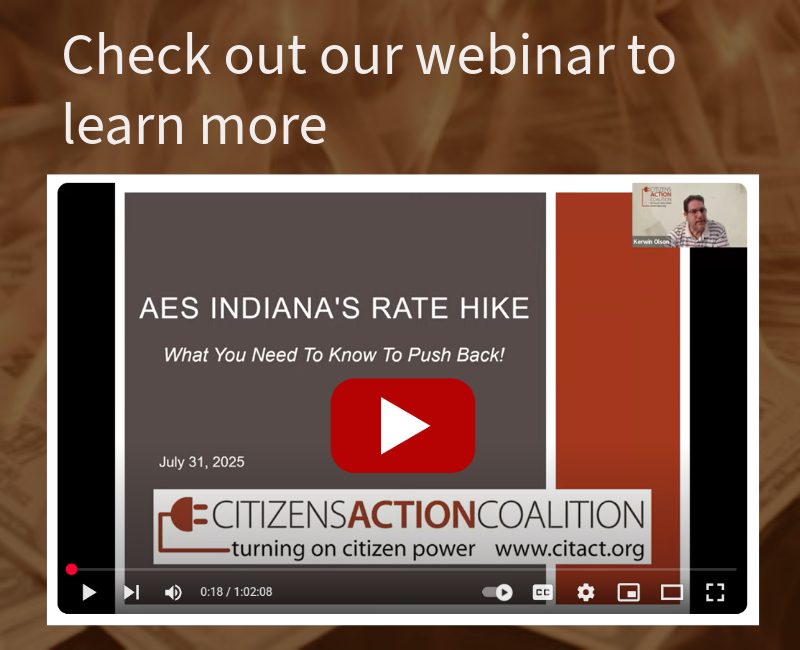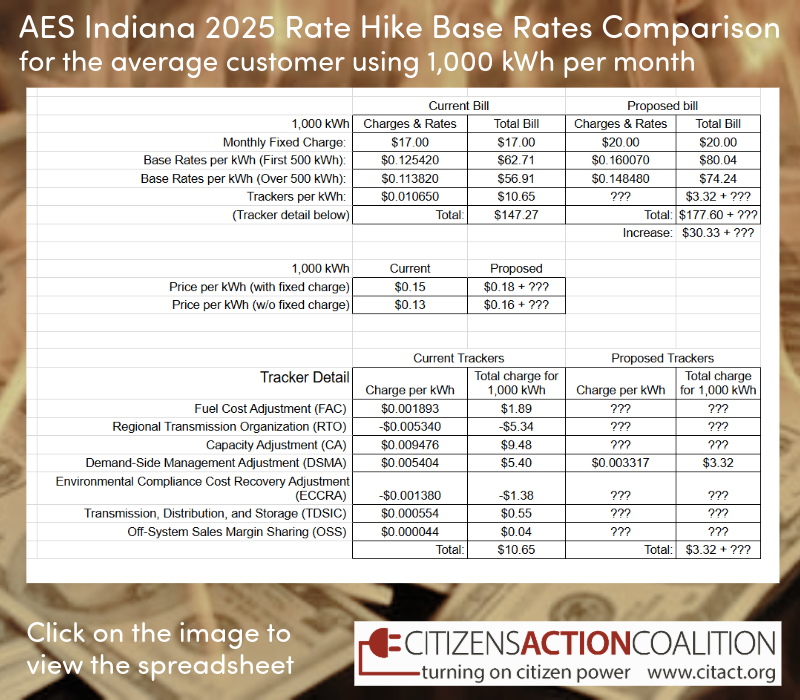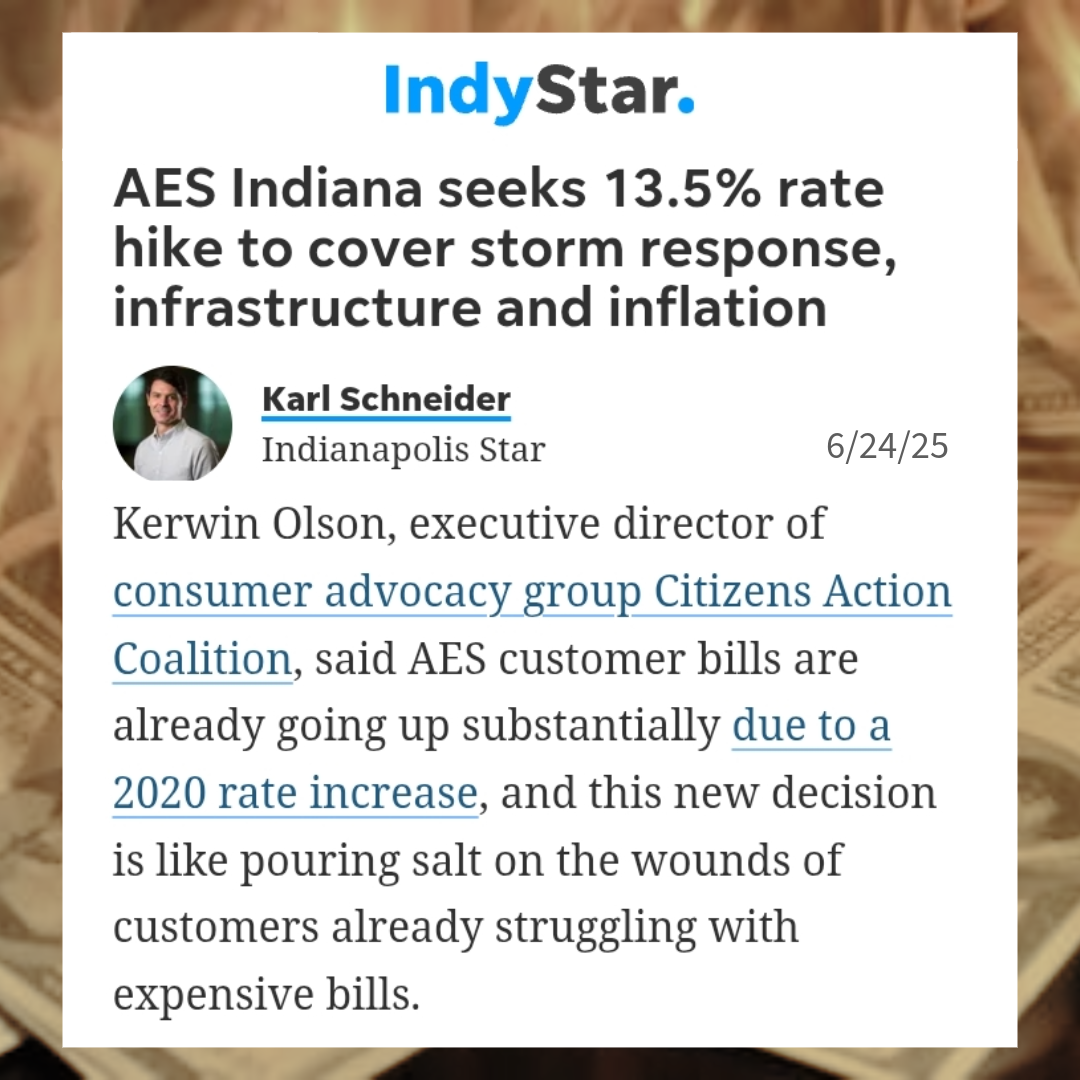AES wants to hike your electric bill by $30/month
In June 2025, as many people in and around Indianapolis struggle to keep up with rising costs of food, housing, and healthcare, AES Indiana filed for a massive rate hike before the Indiana Utility Regulatory Commission (IURC).
![]()
Updates
SEPTEMBER 2025 UPDATE: As intervenors in this case, CAC filed testimony recommending that Indiana utility regulators deny AES Indiana's rate hike in its entirety.
If regulators approve any increase, they should:
-
Deny AES’s request to increase its profit (ROE) and significantly reduce AES Indiana’s current profit.
-
Deny AES’s proposed allocation of costs which forces residential customers to pay a much higher percent increase than large commercial and industrial users. Instead, the IURC should approve a more balanced approach in which residential customers do not end up with a rate increase higher than the system average.
-
Deny Phase 2 rates that are proposed to take effect January 2027. AES’s has refused to provide information about the data centers that could be its customers within the next two years or so. Stakeholders and regulators cannot determine whether Phase 2 rates will be just and reasonable with the game changing addition of data centers, and so should not approve these rates.
We further recommended that regulators should:
-
Open an investigation into AES Indiana’s billing system issues and deny cost recovery related to the new billing system, or the ACE Project.
-
Deny AES Indiana’s proposed increase in the monthly fixed customer charge and modify its request to continue using declining-block rates.
-
Establish a new and lower monthly fixed customer charge for residential customers in multi-family housing.
-
Direct AES Indiana to adopt a security deposit cap of $25 for households who qualify for the Low-Income Home Energy Assistance Program (LIHEAP), and adopt a security deposit cap of $50 for non-LIHEAP residential customers who attest to having a household income below the statewide median household income.
-
Direct AES Indiana to pause residential disconnections for nonpayment for an additional 1-year period, discontinue all disconnections for nonpayment for Medical Alert customers, and eliminate the reconnection charge for residential customers resuming service after being disconnected for a delinquent bill.
-
Direct AES Indiana to automatically waive the first two late payment charges a residential customer gets over a 12-month rolling basis.
-
Reject AES Indiana’s request to force customers to pay for the Company’s expenses related to filing for a rate increase, like experts and lawyers.
-
Establish a new Affordable Power Rider designed to promote economic stability through bill discounts applied to qualifying residential customer bills.
-
Take any other actions necessary to protect residential ratepayers and ensure affordability is appropriately considered and addressed.
![]()
This request - Cause Number 46258 - comes barely a year after their last $9+/month rate hike was approved by state utility regulators in April 2024.
CAC is working to protect Hoosiers from AES's greedy request to collect another $192.9 million every year. We have intervened in this case and will advocate for AES customers throughout the entire rate case.
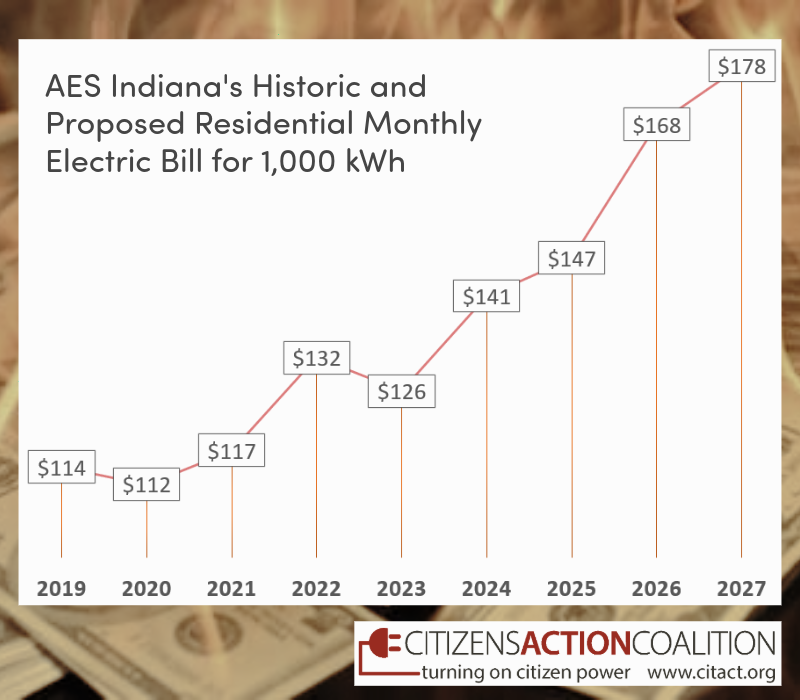 Combined with other, already approved rate increases - for things like transmission and distribution and environmental compliance for polluting fossil-fuel power plants, all enabled by state legislators - the overall increase hitting customer bills is an astonishing $468 million by January 2027.
Combined with other, already approved rate increases - for things like transmission and distribution and environmental compliance for polluting fossil-fuel power plants, all enabled by state legislators - the overall increase hitting customer bills is an astonishing $468 million by January 2027.
If this new request is approved as filed, AES monthly bills will increase $30.32 by January 2027.
In this rate case, AES wants:
-
To collect another $192.9 million from their Indiana customers every year. AES is requesting a 10.1% increase in its annual revenue requirement. If approved, AES will collect $2.11 billion annually from their Indiana customers - residential (households), commercial (big retailers), and industrial (data centers and big manufacturers).
-
To significantly increase their profit. AES already has the highest profit margin (return on equity, or ROE) out of all the investor-owned electric utilities in Indiana at 9.9%. But that’s apparently not enough for this monopoly, which wants regulators to approve an obscene 10.7% ROE for their shareholders. If approved, AES’s annual profit would skyrocket from $260.9 million in 2024 to $417.2 million in 2026, a $156.3 million increase in their net income.
-
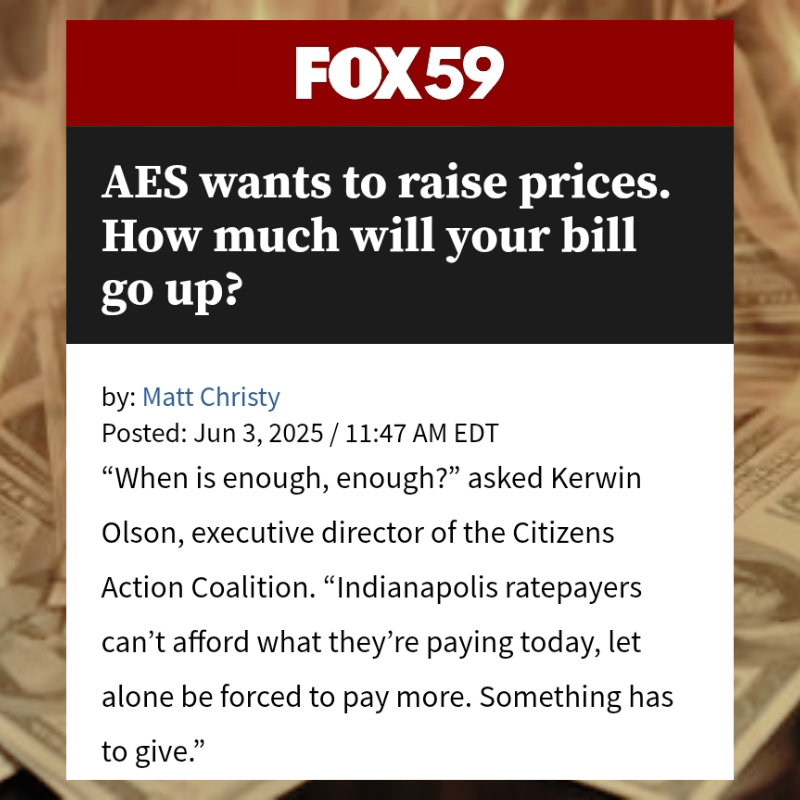 To force residential customers to subsidize the electric bills for large corporate customers by forcing residential customers to pay a higher percentage of the rate increase than large corporations have to pay. AES is proposing the largest rate increase (13.45%) for residential customers, with much smaller rate increases proposed for businesses, including a 6.18% increase for small commercial customers, a 8.72% increase for medium commercial, and a 2.5% increase for large industrial customers (which includes big factories and data centers).
To force residential customers to subsidize the electric bills for large corporate customers by forcing residential customers to pay a higher percentage of the rate increase than large corporations have to pay. AES is proposing the largest rate increase (13.45%) for residential customers, with much smaller rate increases proposed for businesses, including a 6.18% increase for small commercial customers, a 8.72% increase for medium commercial, and a 2.5% increase for large industrial customers (which includes big factories and data centers). -
To charge you the highest fixed charge out of all big utilities in Indiana. AES wants to raise the fixed charge for most residential customers from $17 up to $20. The fixed charge, also known as a customer charge, is the fee you pay every month regardless of how much energy you use.
-
To continue using declining block rates, an absurd and regressive rate structure that forces those who use the least energy to pay the highest rates per kilowatt hour.
High fixed charges and declining block rates are certainly beneficial for AES’s bottom line, but they disproportionately impact low-and fixed-income households (seniors, people with disabilities, households with children, and other vulnerable populations) and penalize households that conserve energy and make their homes more efficient.
The fact that AES Indiana has the gall to ask for higher profits at this point is disturbing.
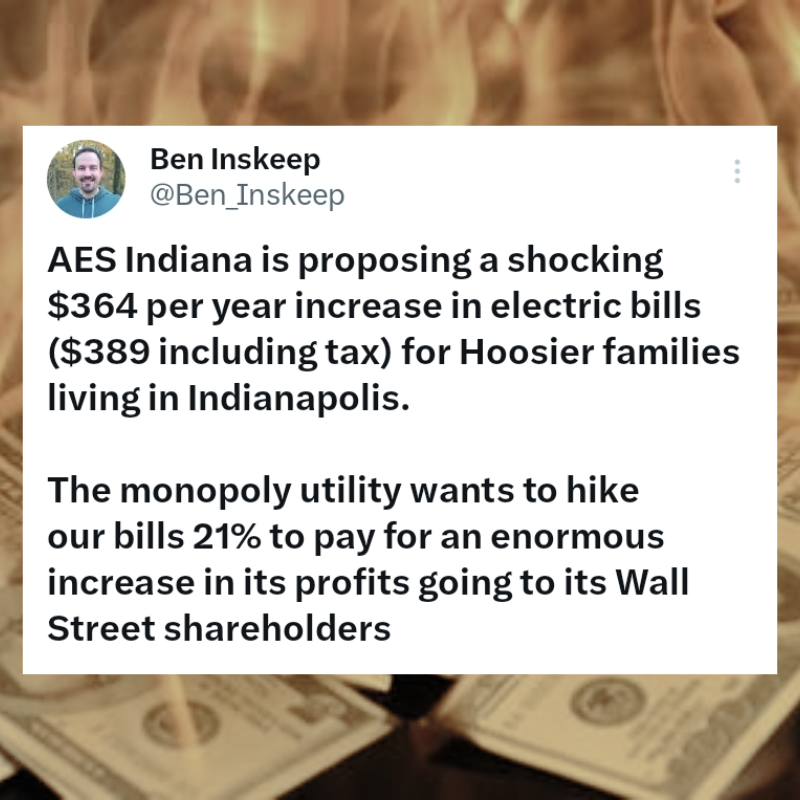 It's been a chaotic and distressing few years for AES customers. Around the time AES filed their last rate case in June 2023, thousands of AES customers were without power, including some for up to 5 days, due to a severe storm. Another recent storm in June 2025 knocked out power to over 60,000 AES customers, and over 10,000 AES customers were still without power as an extreme heat wave moved into the area. For years, AES customers have been communicating concerns about the length of time it takes AES to restore power in the aftermath of storms.
It's been a chaotic and distressing few years for AES customers. Around the time AES filed their last rate case in June 2023, thousands of AES customers were without power, including some for up to 5 days, due to a severe storm. Another recent storm in June 2025 knocked out power to over 60,000 AES customers, and over 10,000 AES customers were still without power as an extreme heat wave moved into the area. For years, AES customers have been communicating concerns about the length of time it takes AES to restore power in the aftermath of storms.
But struggling without power isn’t the only challenge that AES customers have faced in recent years. At the end of 2023, AES's billing system "upgrade" was a complete disaster, causing 60,000 customers to experience a range of billing issues, including being charged for the same bill multiple times. It took all of 2024 and part of 2025 to get these issues resolved.
Campaign Tools
Submit your comments Use the form below to email your comments about AES's rate hike request to Indiana’s Utility Consumer Counselor Bill Fine, urging his office - the OUCC - to oppose the rate hike, and urging the IURC to deny the rate hike. Be sure to reference Cause Number 46258. Help us fight for Hoosiers! Public Comments & Field Hearings We want to thank everyone who submitted comments and testified at the public field hearings! You all submitted over 6,800 comments that the OUCC filed in the AES rate case - thank you so much for speaking out! Between the four IURC public field hearings, there were around 500 folks who attended. There was just over 9 hours of testimony given by around 90 people who spoke directly to utility regulators, and gave oftentimes gut-wrenching testimony about how this rate hike will impact them and their families. Here are links to 3 of the 4 field hearings, recorded by Government Access Television Channel 16: Public Field Hearing #1, 8/18/25 - West Perry Branch Library Public Field Hearing #2, 8/21/25 - Southeast Community Services Public Field Hearing #3, 8/25/25 - New Augusta Public Academy AES Rate Hike Town Hall We want to send out a big thank you to everyone who joined us at our office on August 6th to learn more about the AES rate hike and how to fight back! If you missed it, you can check out the recording below. As bills escalate dramatically, AES offers no support to vulnerable households. As of May 2025, a residential monthly bill for AES customers using 1,000 kilowatt hours (kWh) is $147.27 (excluding sales tax). With this new rate hike factored in, AES is forecasting that monthly bills will increase to $177.60 by January 2027. This results in a $30.32 bill increase over the next year and a half, but AES customers have already been seeing and will continue to see drastic increases in their bills. If this request gets approved, in the 3.5 years between July 2023 and January 2027, AES bills will have increased by an unconscionable $51 per month. These massive bill hikes come at a time when the number of households at or near poverty in Central Indiana continues to grow. In Marion County, over 1 in 3 households is living in or near poverty, the highest percentage of all 7 Central Indiana counties. On the other hand, AES Indiana is a monopoly subsidiary of AES Corporation, a massive US-based Fortune 500 corporation that operates in 12 countries across 4 continents, that pays their executives generously and spends tons of money on political contributions. In other words, AES is doing just fine. So it is disturbing that AES is not proposing any new programs to assist vulnerable households, who already can’t afford their monthly utility bills, and who will struggle even more should the IURC approve this egregious rate hike. This is especially concerning because Indiana offers minimal consumer protections to electric utility customers. Positive legislation that would help keep more vulnerable Hoosiers connected to utility service died at the Indiana Statehouse in the 2025 session, as it did in previous years. Additionally, the federally funded Energy Assistance Program (LIHEAP) is under threat. LIHEAP serves as the primary form of meaningful bill assistance available to vulnerable Hoosier households. All of the workers that administer LIHEAP at the federal level were fired in April, and federal budget proposals have called for eliminating LIHEAP funds entirely. Federal uncertainty, lack of action from the Statehouse, and disinterest in meaningful support from monopoly utilities themselves puts Hoosiers and our health at risk. All Hoosiers deserve uninterrupted access to essential services. No one should have to choose between paying for food, shelter, healthcare or utilities. Our most vulnerable neighbors are put in dangerous positions - even risking their health and well-being - when utility bills are unaffordable. ![]()
![]()
![]()
